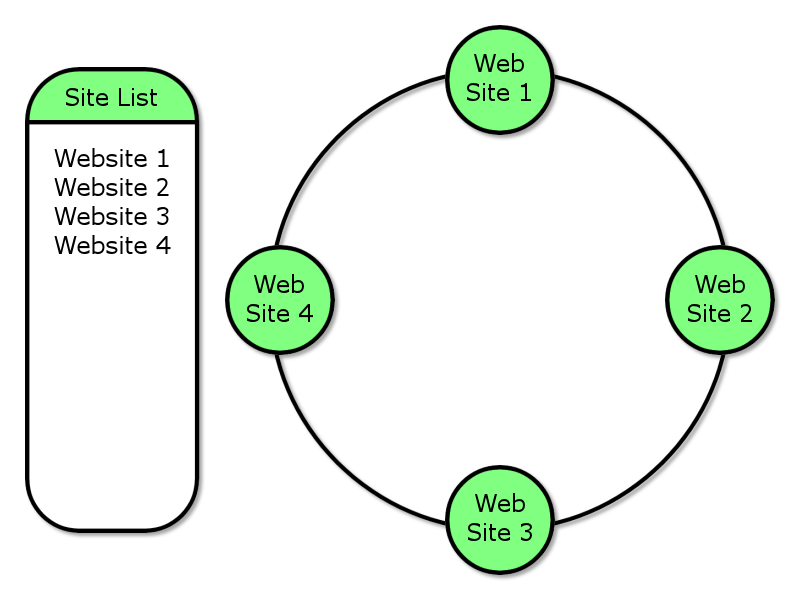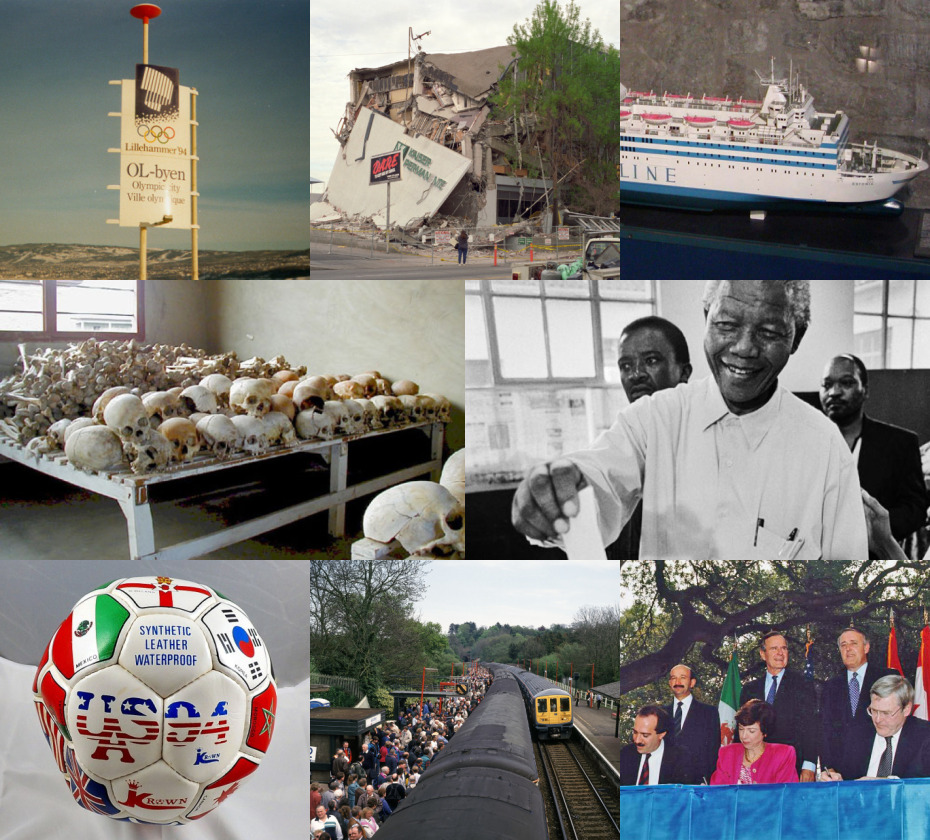|
Webring
A webring (or web ring) is a collection of websites linked together in a circular structure, usually organized around a specific theme, and often educational or social. They were popular in the 1990s and early 2000s, particularly among amateur websites. To be a part of the webring, each site has a common navigation bar; it contains links to the previous and next sites. By selecting next (or previous) repeatedly, the user will eventually reach the site they started at; this is the origin of the term "webring." However, the select-through route around the ring is usually supplemented by a central site with links to all member sites; this prevents the ring from breaking completely if a member site goes offline. A webring is managed from one website which is able to omit the websites that have dropped out or are no longer reachable. The advantage of a webring is that if the user is interested in the topic on one website, they can quickly connect to another website on the same topic. ... [...More Info...] [...Related Items...] OR: [Wikipedia] [Google] [Baidu] |
Web Directory
A web directory or link directory is an online list or catalog of websites. That is, it is a directory on the World Wide Web of (all or part of) the World Wide Web. Historically, directories typically listed entries on people or businesses, and their contact information; such directories are still in use today. A web directory includes entries about websites, including links to those websites, organized into categories and subcategories. Besides a link, each entry may include the title of the website, and a description of its contents. In most web directories, the entries are about whole websites, rather than individual pages within them (called "deep links"). Websites are often limited to inclusion in only a few categories. There are two ways to find information on the Web: by searching or browsing. Web directories provide links in a structured list to make browsing easier. Many web directories combine searching and browsing by providing a search engine to search the directory. U ... [...More Info...] [...Related Items...] OR: [Wikipedia] [Google] [Baidu] |
Web Navigation
Web navigation refers to the process of navigating a network of information resources in the World Wide Web, which is organized as hypertext or hypermedia. The user interface that is used to do so is called a web browser. A central theme in web design is the development of a web navigation interface that maximizes usability. A website overall navigational scheme includes several navigational pieces such as global, local, supplemental, and contextual navigation; all of these are vital aspects of the broad topic of web navigation. Hierarchical navigation systems are vital as well since it is the primary navigation system. It allows for the user to navigate within the site using levels alone, which is often seen as restricting and requires additional navigation systems to better structure the website. The global navigation of a website, as another segment of web navigation, serves as the outline and template in order to achieve an easy maneuver for the users accessing the site, ... [...More Info...] [...Related Items...] OR: [Wikipedia] [Google] [Baidu] |
Hashtag
A hashtag is a metadata tag operator that is prefaced by the hash symbol, ''#''. On social media, hashtags are used on microblogging and photo-sharing services–especially Twitter and Tumblr–as a form of user-generated tagging that enables cross-referencing of content by topic or theme. For example, a search within Instagram for the hashtag ''#bluesky'' returns all posts that have been tagged with that term. After the initial hash symbol, a hashtag may include letters, numerals or other punctuation. The use of hashtags was first proposed by American blogger and product consultant Chris Messina in a 2007 tweet. Messina made no attempt to patent the use because he felt that "they were born of the internet, and owned by no one". Hashtags became entrenched in the culture of Twitter and soon emerged across Instagram, Facebook, and YouTube. In June 2014, ''hashtag'' was added to the ''Oxford English Dictionary'' as "a word or phrase with the symbol ''#'' in front of it, used o ... [...More Info...] [...Related Items...] OR: [Wikipedia] [Google] [Baidu] |
Yahoo!
Yahoo (, styled yahoo''!'' in its logo) is an American web portal that provides the search engine Yahoo Search and related services including My Yahoo, Yahoo Mail, Yahoo News, Yahoo Finance, Yahoo Sports, y!entertainment, yahoo!life, and its advertising platform, Yahoo Native. It is operated by the namesake company Yahoo! Inc. (2017–present), Yahoo! Inc., which is 90% owned by Apollo Global Management and 10% by Verizon. Yahoo was established by Jerry Yang and David Filo in January 1994 and was one of the pioneers of the early Internet era in the 1990s. However, its use declined in the 2010s as some of its services were discontinued, and it lost market share to Facebook and Google. Etymology The word "yahoo" is a backronym for "Yet another, Yet Another Hierarchically Organized Oracle" or "Yet Another Hierarchical Officious Oracle". The term "hierarchical" described how the Yahoo database was arranged in layers of subcategories. The term "oracle" was intended to mean "sourc ... [...More Info...] [...Related Items...] OR: [Wikipedia] [Google] [Baidu] |
Internet Properties Established In 1995
The Internet (or internet) is the global system of interconnected computer networks that uses the Internet protocol suite (TCP/IP) to communicate between networks and devices. It is a network of networks that consists of private, public, academic, business, and government networks of local to global scope, linked by a broad array of electronic, wireless, and optical networking technologies. The Internet carries a vast range of information resources and services, such as the interlinked hypertext documents and applications of the World Wide Web (WWW), electronic mail, internet telephony, streaming media and file sharing. The origins of the Internet date back to research that enabled the time-sharing of computer resources, the development of packet switching in the 1960s and the design of computer networks for data communication. The set of rules (communication protocols) to enable internetworking on the Internet arose from research and development commissioned in th ... [...More Info...] [...Related Items...] OR: [Wikipedia] [Google] [Baidu] |
1994 Introductions
The year 1994 was designated as the "International Year of the Family" and the "International Year of Sport and the Olympic Charter, Olympic Ideal" by the United Nations. In the Line Islands and Phoenix Islands of Kiribati, 1994 had only 364 days, omitting December 31. This was due to an adjustment of the International Date Line by the Kiribati government to bring all of its territories into the same calendar day. Events January * January 1 ** The North American Free Trade Agreement (NAFTA) is established. ** Beginning of the Zapatista uprising in Mexico. * January 8 – ''Soyuz TM-18'': Valeri Polyakov begins his 437.7-day orbit of the Earth, eventually setting the world record for days spent in orbit. * January 11 – The Irish government announces the end of a 15-year broadcasting ban on the Provisional Irish Republican Army and its political arm Sinn Féin. * January 14 – U.S. President Bill Clinton and Russian President Boris Yeltsin sign the Kremlin accords, which ... [...More Info...] [...Related Items...] OR: [Wikipedia] [Google] [Baidu] |
Web 1
Web most often refers to: * Spider web, a silken structure created by the animal * World Wide Web or the Web, an Internet-based hypertext system Web, WEB, or the Web may also refer to: Computing * WEB, a literate programming system created by Donald Knuth * GNOME Web, a Web browser * Web.com, a web-design company * Webs (web hosting), a Web hosting and website building service * Web hosting service Engineering * Web (manufacturing), continuous sheets of material passed over rollers ** Web, a roll of paper in offset printing * Web, the vertical element of an I-beam or a rail profile * Web, the interior beams of a truss Films * ''Web'' (2013 film), a documentary * ''Webs'' (film), a 2003 science-fiction movie * ''The Web'' (film), a 1947 film noir * Charlotte's Web (2006 film) Literature * ''Web'' (comics), an MLJ comicbook character (created 1942) * ''Web'' (novel), by John Wyndham (1979) * The Web (series), a science fiction series (1997–1999) * World English Bib ... [...More Info...] [...Related Items...] OR: [Wikipedia] [Google] [Baidu] |
Methods Of Website Linking
In the field of search engine optimization (SEO), link building describes actions aimed at increasing the number and quality of inbound links to a webpage with the goal of increasing the search engine rankings of that page or website. Briefly, link building is the process of establishing relevant hyperlinks (usually called links) to a website from external sites. Link building can increase the number of high-quality links pointing to a website, in turn increasing the likelihood of the website ranking highly in search engine results. Link building is also a proven marketing tactic for increasing brand awareness. Link types Editorial link Editorial links are the links not acquired from paying money, asking, trading or exchanging. These links are attracted because of the good content and marketing strategies of a website. These are the links that the website owner does not need to ask for as they are naturally given by other website owners. Resource link Resource links are ... [...More Info...] [...Related Items...] OR: [Wikipedia] [Google] [Baidu] |
Article Directory
Social bookmarking is an online service which allows users to add, annotate, edit, and share bookmarks of web documents. Many online bookmark management services have launched since 1996; Delicious, founded in 2003, popularized the terms "social bookmarking" and " tagging". Tagging is a significant feature of social bookmarking systems, allowing users to organize their bookmarks and develop shared vocabularies known as folksonomies. Common features Unlike file sharing, social bookmarking does not save the ''resources'' themselves, merely bookmarks that ''reference'' them, i.e. a link to the bookmarked page. Descriptions may be added to these bookmarks in the form of metadata, so users may understand the content of the resource without first needing to download it for themselves. Such descriptions may be free text comments, votes in favor of or against its quality, or tags that collectively or collaboratively become a folksonomy. Folksonomy is also called ''social tagging'', "th ... [...More Info...] [...Related Items...] OR: [Wikipedia] [Google] [Baidu] |
Proprietary Software
Proprietary software is computer software, software that grants its creator, publisher, or other rightsholder or rightsholder partner a legal monopoly by modern copyright and intellectual property law to exclude the recipient from freely sharing the software or modifying it, and—in some cases, as is the case with some patent-encumbered and EULA-bound software—from making use of the software on their own, thereby restricting their freedoms. Proprietary software is a subset of non-free software, a term defined in contrast to free and open-source software; non-commercial licenses such as CC BY-NC are not deemed proprietary, but are non-free. Proprietary software may either be closed-source software or source-available software. Types Origin Until the late 1960s, computers—especially large and expensive mainframe computers, machines in specially air-conditioned computer rooms—were usually leased to customers rather than Sales, sold. Service and all software available ... [...More Info...] [...Related Items...] OR: [Wikipedia] [Google] [Baidu] |
Cybersquatting
Cybersquatting (also known as domain squatting) is the practice of registering, trafficking in, or using an Internet domain name, with a bad faith intent to profit from the goodwill of a trademark belonging to someone else. The term is derived from " squatting", which is the act of occupying an abandoned or unoccupied space or building that the squatter does not own, rent, or otherwise have permission to use. Terminology In popular terms, "cybersquatting" is the term most frequently used to describe the deliberate, bad faith abusive registration of a domain name in violation of trademark rights. However, precisely because of its popular currency, the term has different meanings to different people. Some people, for example, include "warehousing", or the practice of registering a collection of domain names corresponding to trademarks with the intention of selling the registrations to the owners of the trademarks, within the notion of cybersquatting, while others distinguish betw ... [...More Info...] [...Related Items...] OR: [Wikipedia] [Google] [Baidu] |





